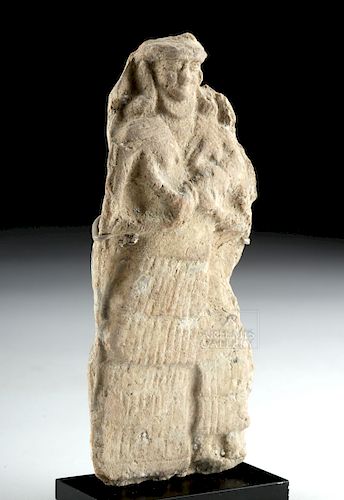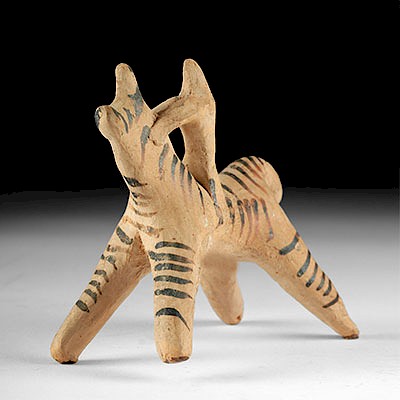Mesopotamian Terracotta Mother Goddess Figure
Lot 109c
About Seller
Artemis Fine Arts
686 S Taylor Ave, Ste 106
Louisville, CO 80027
United States
Selling antiquities, ancient and ethnographic art online since 1993, Artemis Gallery specializes in Classical Antiquities (Egyptian, Greek, Roman, Near Eastern), Asian, Pre-Columbian, African / Tribal / Oceanographic art. Our extensive inventory includes pottery, stone, metal, wood, glass and textil...Read more
Estimate:
$1,200 - $1,800
Absentee vs Live bid
Two ways to bid:
- Leave a max absentee bid and the platform will bid on your behalf up to your maximum bid during the live auction.
- Bid live during the auction and your bids will be submitted real-time to the auctioneer.
Bid Increments
| Price | Bid Increment |
|---|---|
| $0 | $25 |
| $300 | $50 |
| $1,000 | $100 |
| $2,000 | $250 |
| $5,000 | $500 |
| $10,000 | $1,000 |
| $20,000 | $2,500 |
| $50,000 | $5,000 |
| $100,000 | $10,000 |
| $200,000 | $20,000 |
About Auction
By Artemis Fine Arts
Oct 25, 2018
Set Reminder
2018-10-25 11:00:00
2018-10-25 11:00:00
America/New_York
Bidsquare
Bidsquare : Antiquities from Egypt, Greece, Italy, Asia
https://www.bidsquare.com/auctions/artemis-gallery/antiquities-from-egypt-greece-italy-asia-3538
Featuring Egyptian, Greek, Roman, Etruscan, Near Eastern, plus Asian art from Central and Far East. If you love the classics, this is the sale for you. Artemis Fine Arts info@artemisfinearts.com
Featuring Egyptian, Greek, Roman, Etruscan, Near Eastern, plus Asian art from Central and Far East. If you love the classics, this is the sale for you. Artemis Fine Arts info@artemisfinearts.com
- Lot Description
Ancient Near East, Mesopotamia, ca. 1600 BCE. A fabulous section of a mold-made terracotta relief plaque depicting a female holding an infant with the lower section of a child to her left (notice the two tiny legs posed in profile toward the left). This figure likely represents the Mesopotamian Mother Goddess known by several names (Ninmah, Nintud, Nintur, Belet-ili). She was associated with pregnancy and childbirth and was thought to guide children in the womb and nourish them after birth. Size: 2.125" W x 4.875" H (5.4 cm x 12.4 cm); 5.125" H (13 cm) on included custom stand.
The mother goddess was also oftentimes presented as the creator of humankind. According to Nicole Brisch, "In the Akkadian myth of Atrahasis, the Mesopotamian flood story, Nintur created humankind by mixing clay with blood of a slain god (Lambert and Millard 1969: 57-61), and in the Sumerian tale of Enki and Ninmah (ETCSL 1.1.2) the two deities compete by creating various creatures out of clay, resulting ultimately in the creation of humans. The clay is said to come from the top of the abzu TT , the cosmic underground waters. In her role as the creator of humankind she is eventually replaced by the god Enki/Ea, as visible in Enuma eliš TT (tablet VI, lines 32-36). Frymer-Kensky (1992: 70-80) referred to the diminishing importance of goddesses even in primarily female functions, such as creation, as the "marginalization of goddesses"." (Nicole Brisch, 'Mother Goddess (Ninmah, Nintud/r, Belet-ili)', Ancient Mesopotamian Gods and Goddesses, Oracc and the UK Higher Education Academy, 2013 [http://oracc.iaas.upenn.edu/amgg/listofdeities/mothergoddess/]
Provenance: private East Coast, USA collection
All items legal to buy/sell under U.S. Statute covering cultural patrimony Code 2600, CHAPTER 14, and are guaranteed to be as described or your money back.
A Certificate of Authenticity will accompany all winning bids.
We ship worldwide and handle all shipping in-house for your convenience.
#135559A section with losses to peripheries and abrasions to surface as shown. Still quite strong with wonderful detailed modeling and areas of mineral deposits.Condition
- Shipping Info
-
All shipping is handled in-house for your convenience. Your invoice from Artemis Gallery will include shipping calculation instructions. If in doubt, please inquire BEFORE bidding for estimated shipping costs for individual items.
-
- Buyer's Premium



 EUR
EUR CAD
CAD AUD
AUD GBP
GBP MXN
MXN HKD
HKD CNY
CNY MYR
MYR SEK
SEK SGD
SGD CHF
CHF THB
THB














